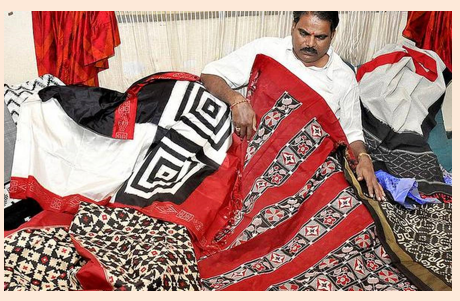Telia Rumal got Geographical Indication (GI) tag
- Posted By
10Pointer
- Categories
Miscellaneous
- Published
14th May, 2020
-
-
Context
- Telangana’s Telia Rumal has been given the Geographical Indication (GI) tag by the Geographical Indications Registry headquartered in Chennai.
-
Who made the application?
- The application for Telia Rumal was made by the Consortium of Puttapaka Handloom Cluster-IHDS.
-
History of Telia Rumal
- During the Nizam’s dynasty, Puttapaka, a small, backward village of the Telangana region of Andhra Pradesh had about 20 families engaged in handloom weaving, who were patronised by rich Muslim families, Damsthanams and the Nizam rulers.
- The Gajam family have lived in Puttapaka for the last 100 years having a pioneering history of producing the Telia Rumal.
- The officers working in the court of the Nizam would wear the Chituki Telia Rumal as a symbolic representation of status.
- Telia Rumals are offered at the dargah of Ajmer Sharif in Rajasthan, with some devotees offering 50 or even 100 cloths.
- Telia Rumals were worn as a veil by princesses at the erstwhile court of the Nizam of Hyderabad; and as a turban cloth by Arabs in the Middle East.
-
What is Telia Rumal?
- Telia Rumal literally means ‘Oily handkerchief’. The craft has its origin in Andhra Pradesh and dates back to early 19th Century.
- Though it started in Chirala its currently practiced by a few weavers in Puttapaka village of Nalgonda district. The rectangular telia cloths were used as a veil/scarves by women and a multipurpose cloth by men ( turban,lungi, shoulder cloth ).
- The Telia Rumal is a double Ikat weave. The word Ikat is derived from the Malay-Indonesian word mang-ikat, which means to bind or knot, as the yarn that goes into the weave is tied and dyed before being woven.
-
How is it made?
- Telia rumal is a very intricate and laborious double ikat weave. As the name suggests the yarn is treated with oil.
- The products used for the treatment of the yarn are sheep dung castor pod ashes and oil. The treated yarn which is used for the warp ( length ) and weft ( width ) is tied and dyed in accordance with a predetermined geometrical design.
- Each of the warp and weft threads are individually positioned on the loom prior to weaving hence it’s crucial for the weaver to ensure perfection.
- Only 3 colors are traditionally used – red black and white in geometrical designs.
- Weaving a telia rumal needs a great amount of practice and perfection for the warp and weft to be meticulously converted to an artistic design.
- The number of motifs makes it more complex and difficult to weave. Telia comes from tel (oil)—in Chirala, a coastal town in Guntur district where the Telia Rumal was woven in the 19th century, the yarn was treated with a mixture of castor ash and oil to help it retain colour and lend it cooling properties.
- The properties of tel and the lineage of rumal make the Telia Rumal distinct from, and superior to, the Nalgonda Ikat or Pochampally Ikat saris.
-
What is the current scenario?
- Puttapaka is a village in the Narayanpur mandal/samsthan of Nalgonda district of Andhra Pradesh . Its famous for its tie and dye sarees mainly the Telia Rumal. The community of weavers are known as the Puttapaka Padmashalis.
- Only a couple of weavers from the Padmashali community are currently practicing this exquisite craft in the village of Puttapaka.
- Due to the laborious process of the oil treatment, it has been done away with and alizarin dyes are being used. It still takes over two months to weave a saree.
- Most other weavers have now taken to the single and double ikat form of weaving and introduced modern designs.
- The master weavers who have won national awards for the telia rumal still take pride in talking about this craft and say that with a little support coming from the government the telia rumal is set for a comeback.
- The number of weavers committing suicide is also seeing a decline. Small initiatives like providing yarn to the weavers at subsidized rate may help.

-
